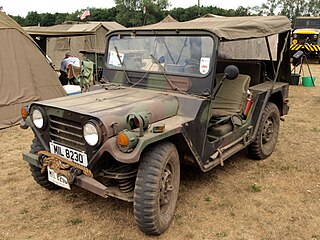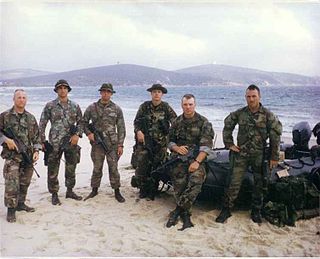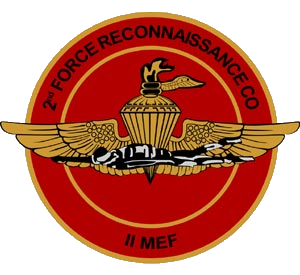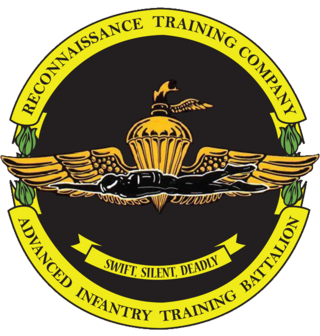
A Marine expeditionary unit is the smallest air-ground task force (MAGTF) in the United States Fleet Marine Force. Each MEU is an expeditionary rapid reaction force ready to answer any crisis, whether it be disaster aid or a combat mission. Marine amphibious unit (MAU) was the name used until the late 1980s.

Force Reconnaissance (FORECON) are United States Marine Corps deep reconnaissance companies that supply military intelligence to the command element of the Marine Air-Ground Task Force (MAGTF). Force Reconnaissance companies unlike USMC division reconnaissance report to the Marine expeditionary force (MEF) and provide direct action and deep reconnaissance during large-scale operations.

The Mercedes-Benz G-Class, colloquially known as the G-Wagen is a four-wheel drive automobile manufactured by Magna Steyr in Austria and sold by Mercedes-Benz. Originally developed as a military off-roader, later more luxurious models were added to the line. In certain markets, it was sold under the Puch name as Puch G until 2000.

The Desert Patrol Vehicle (DPV), formerly called the Fast Attack Vehicle (FAV), is a Chenowth high-speed, lightly armored sandrail-like vehicle first used in combat during the Gulf War in 1991. Due to their dash speed and off-road mobility, the DPVs were used extensively during Operation Desert Storm. The first U.S. forces to enter Kuwait City were United States Navy SEALs in DPVs.

The Truck, Utility, ¼-Ton, 4×4, or simply M151 was the successor to the Korean War M38 and M38A1 Jeep Light Utility Vehicles. The M151 had an integrated body design which offered a little more space than prior jeeps, and featured all-around independent suspension with coil springs. It has since been replaced by the larger AM General HMMWV in most utility roles in frontline use. With some M151A2 units still in U.S. military service in 1999, the M151 series achieved a longer run of service than that of the World War II/Korean War-era MB/GPW, M38, and M38A1 series combined.

2nd Light Armored Reconnaissance Battalion is a fast and mobilized armored terrestrial reconnaissance battalion of the United States Marine Corps. Their primary weapon system is the 8-wheeled LAV-25 and they fall under the command of the 2nd Marine Division and II Marine Expeditionary Force. The unit is based out of the Marine Corps Base Camp Lejeune, North Carolina. The current mission statement of the battalion is: To perform combined arms reconnaissance and security missions in support of the Ground Combat Element (GCE) of a Marine Air-Ground Task Force (MAGTF). Its mission is to conduct reconnaissance, security and economy of force operations, and, within its capabilities, limited offensive or defensive operations that exploit the unit's mobility and firepower.

The Radio Reconnaissance Platoon is a specially trained Marine Corps Intelligence element of a United States Marine Corps Radio Battalion. A Radio Reconnaissance Team (RRT) was assigned as the tactical signals intelligence collection element for the Marine Corps Special Operations Command, Detachment One. Regular RRTs also participate in SOC operations during Marine Expeditionary Unit, or MEU(SOC), deployments.
In the United States Marine Corps, a Marine Air–Ground Task Force is the principal organization for all missions across the range of military operations. MAGTFs are a balanced air–ground, combined arms task organization of Marine Corps forces under a single commander that is structured to accomplish a specific mission. The MAGTF was formalized by the publishing of Marine Corps Order 3120.3 in December 1963, "The Marine Corps in the National Defense, MCDP 1-0". It stated:
A Marine air–ground task force with separate air ground headquarters is normally formed for combat operations and training exercises in which substantial combat forces of both Marine aviation and Marine ground units are included in the task organization of participating Marine forces.

1st Reconnaissance Battalion is a reconnaissance battalion in the United States Marine Corps. It is a stand-alone battalion with no parent regiment. Instead, it falls directly under the command of the 1st Marine Division. 1st Recon Bn is located at Marine Corps Base Camp Pendleton in San Diego, California.

The Portuguese Marine Corps constitutes the Elite Marine Commandos and the Special Operations Branch of the Portuguese Navy. It has roles similar to the ones of the USMC Reconnaissance Battalions and of the Royal Marine Commandos and the 75th Ranger Regiment The Corps is specialised in air assault, amphibious warfare, anti-tank warfare, coastal reconnaissance and raiding, commando style raids, counterinsurgency, desert warfare, indirect fire support raiding, irregular warfare, ISTAR, jungle warfare, maneuver warfare, maritime interdiction, mountain warfare, providing security at naval base or shore stations, reconnaissance for gathering military intelligence, support special operations, tracking targets, urban warfare, and VBSS operations. It is an Elite Marine Commando Force, operating as a rapid-reaction force. Today's Corpo de Fuzileiros is the premier raid force. The Fuzileiros remains an all-volunteer force with an intensive screening and selection process followed by combat-focused training. Fuzileiros are resourced to maintain exceptional proficiency, experience and readiness.

The MEU(SOC) pistol, officially designated the M45 MEUSOC, is a magazine-fed, recoil-operated, single-action, semiautomatic pistol chambered for the .45 ACP cartridge. It is a variant of the M1911 for use by the Force Recon Element of the United States Marine Corps' Marine Expeditionary Units from 1985 until 2022. It is assigned NATO Stock Number 1005-01-370-7353.
The United States Marine Corps is tasked by Department of Defense directive to "conduct complex expeditionary operations in the urban littorals and other challenging environments" and "conduct amphibious operations, including engagement, crisis response, and power projection operations to assure access." Before 2006, the Marine Corps was the only branch of the Armed Forces that did not have any of its special warfare elements participating in the United States Special Operations Command (USSOCOM), due to confining its special operations capabilities only for the purpose to the Fleet Marine Force.
The reconnaissance mission within the United States Marine Corps is divided into two distinct but complementary aspects; Marine Division Recon and Force Reconnaissance.

1st Force Reconnaissance Company conducted deep reconnaissance and direct action raids in support of I Marine Expeditionary Force requirements across the range of military operations to include crisis response, expeditionary operations and major combat operations. 1st Force Recon Company was deactivated on 26 October 2006 and the majority of the personnel were used to establish the 1st Marine Special Operations Battalion.

The Second Force Reconnaissance Company was the deep reconnaissance/direct action that was assigned to the Fleet Marine Force, Atlantic and its subordinate elements of the Marine Air-Ground Task Force.

The M1161 Growler is officially the Internally Transportable Light Strike Vehicle (ITV-LSV) designed specifically for use with the V-22 Osprey tiltrotor aircraft. The M1161 and M1163 are the only tactical vehicles certified to fly in the V-22. Fulfilling multiple roles of light utility, light strike and fast attack vehicle, the M1161 Growler is smaller than most international vehicles in the same role. It has taken over duties of the M151 jeep-type variants and replaced the Interim Fast Attack Vehicle (IFAV).

The two amphibious/ground reconnaissance assets of the United States Marine Corps, Division and Force Reconnaissance, are generally trained in the same aspect and environment of intelligence collection for a Marine Air Ground Task Force (MAGTF) Commander, regardless of their difference in tactical area of responsibility (TAOR). However, in light of their distinctive responsibilities in their assigned areas of operations—whereas Division Recon conducts close and distant operations, Force Recon conducts deep operations—these two separate reconnaissance assets manage their own training protocols to fit their mission-oriented objectives.















